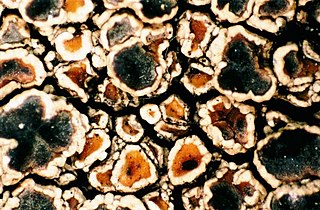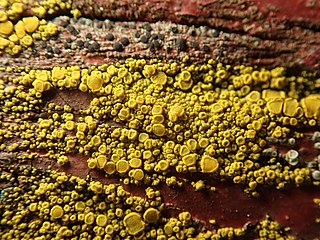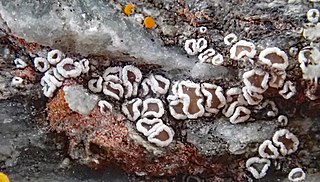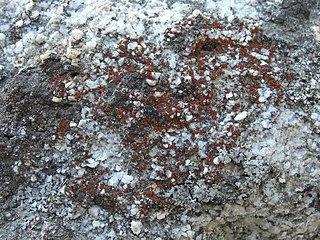
Aspicilia is a genus of mostly crustose areolate lichens that grow on rock. Most members have black apothecia discs that are slightly immersed in the areolas, hence the common name.

Megasporaceae are a family of fungi belonging to the order Pertusariales. Taxa are lichenized with green algae, and grow on rocks, often in maritime climates close to fresh water. Phylogenetic analysis has shown that this family is related to the Pertusariaceae, another family of lichens. The genus Aspicilia was moved here from the Hymeneliaceae.

The Lecanoraceae are a family of lichenized fungi in the order Lecanorales. Species of this family have a widespread distribution.

The Teloschistaceae are a large family of mostly lichen-forming fungi belonging to the class Lecanoromycetes in the division Ascomycota. The family, estimated to contain over 1800 species, was extensively revised in 2013, including the creation or resurrection of 31 genera. It contains four subfamilies: Brownlielloideae, Xanthorioideae, Caloplacoideae, and Teloschistoideae.

The Physciaceae are a family of mostly lichen-forming fungi belonging to the class Lecanoromycetes in the division Ascomycota. A 2016 estimate placed 19 genera and 601 species in the family.
Rimularia is a genus of lichenized fungi in the family Trapeliaceae. Rimularia was circumscribed by Finnish botanist William Nylander in 1868.

Phaeophyscia is a genus of lichen-forming fungi in the family Physciaceae.

Candelariella is a genus of bright yellow, ocher, or greenish yellow crustose or squamulose lichens in the family Candelariaceae. Members of the genus are commonly called eggyolk lichens, goldspeck lichens, or yolk lichens.

Gyalidea is a genus of crustose lichens in the family Gomphillaceae. It has 50 species.

Gyalecta is a genus of fungi in the family Gyalectaceae that contains 50 species. Gyalecta was circumscribed by lichenologist Erik Acharius in 1808.

Fuscidea is a genus of crustose lichens in the family Fuscideaceae. It has about 40 species. The genus was circumscribed in 1972 by lichenologists Volkmar Wirth and Antonín Vězda, with Fuscidea aggregatilis assigned as the type species.

Lobothallia is a genus of lichens in the family Megasporaceae. Species in the genus have foliose thalli that become crustose areolate in the center with age, and grow on calcareous to siliceous rocks. The crustose part of the body may keep its lower cortex, though not always. Dark brown to black apothecia may be sunken into the surface of the thallus, as indicated in the common name puffed sunken disk lichen. Members grow to 3–5 cm (1.2–2.0 in) or more radiating lobes (placoidioid). The photobiont is green alga from the genus Trebouxia. The genus is represented in Eurasia, Asia, North Africa, Central America, western North America, and Australia.

Myriolecis is a genus of lichen in the family Lecanoraceae. It was originally circumscribed in 1909 by Frederic E. Clements with Myriolecis sambuci as the type species. The genus was later reinstated to accommodate the Lecanora disperse group and Arctopeltis. Molecular phylogenetic data showed that this group of species formed a clade that is genetically distinct from Lecanora, and Myriolecis was the oldest name available to hold these species.

Flavoplaca is a genus of crust-like or scaly lichens in the family Teloschistaceae. It has 28 species with a mostly Northern Hemisphere distribution.

Xanthocarpia is a genus of mostly crustose lichens in the family Teloschistaceae. It has 12 species with a largely Northern Hemisphere distribution.

Rufoplaca is a genus of lichen-forming fungi in the family Teloschistaceae. The genus was circumscribed in 2013 by Ulf Arup, Ulrik Søchting, and Patrik Frödén.

Squamulea is a genus of lichen-forming fungi in the family Teloschistaceae. It has 15 species. The genus was circumscribed in 2013 by Ulf Arup, Ulrik Søchting, and Patrik Frödén, with Squamulea subsoluta assigned as the type species. Five species were included in the original account of the genus. The genus name alludes to the squamulose growth form of most of its species. Squamulea has a worldwide distribution; when the genus was originally created, the centre of distribution was thought to be in southwestern North America.
















